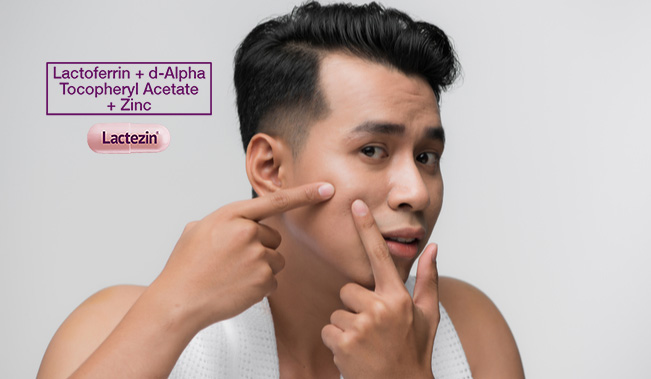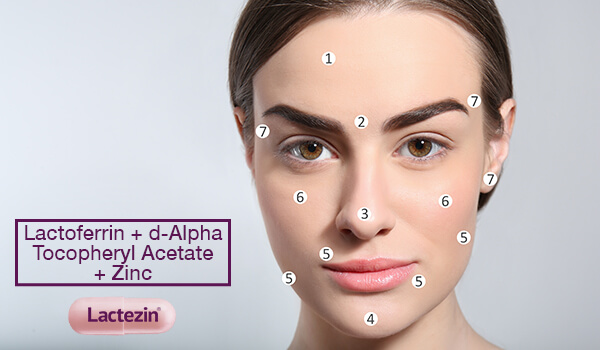5 Types of Acne and How to Heal Them

When a bump appears on your face, you automatically think it’s a pimple. The bad news: sometimes it might be something else. Fortunately, there’s a way to manage each type of acne. You just have to figure out exactly what it is you’re dealing with and start from there!
How does acne occur?
Before we get into the specifics, let’s go back to how it all starts. Acne, that is.
Acne occurs when your skin’s pores become blocked with oil, bacteria, or dead skin. Each pore is the opening to a follicle, which is made up of a hair and a sebaceous gland. Your oil glands release sebum (oil), which travels out of the pore and onto the skin. The sebum is actually good; it keeps your skin naturally lubricated and soft.
However, some problems happen during this process and cause acne: when too much oil is produced, when dead skin cells build up in the pores, and when bacteria is added into the mix. These problems contribute to the development of pimples. As bacteria grow inside the pore, they cause the inflammation and redness we typically see in breakouts.
Some factors that contribute to acne also include:
- Hormonal changes caused by puberty, pregnancy, or even stress
- Certain medications, such as birth control pills or corticosteroids
- A diet high in refined sugars
- Heredity, or if acne runs in the family
What are the types of acne?
Acne can be classified into two main categories, inflammatory and non-inflammatory acne, depending on whether or not they cause inflammation of the surrounding skin.
Non-inflammatory Acne
Whiteheads
Medically referred to as closed comedones, whiteheads are small, white or flesh-colored spots or bumps. Usually they appear to have a white, circular center surrounded by a red halo. These typically do not cause scarring unless you squeeze them out, which is why it’s generally advised not to do so.
Treatment: Use a chemical exfoliant like AHA (alpha-hydroxy acid), which is an effective exfoliator that can remove the outermost layer of dead skin cells, revealing brighter, fresher skin. Use it once or twice a week, depending on how your skin reacts to the product.
Read more: Your Cheat Sheet to Fighting Whiteheads
Blackheads
On the other hand, blackheads are referred to as open comedones, and they’re called such because they look like small, black or dark-colored spots that are slightly raised. Their color isn’t because of trapped dirt; blackheads are just whiteheads that have opened and have been exposed to air, darkening as a result.
Treatment: Use a gentle, water-soluble cleanser to thoroughly cleanse the skin without overdoing it. It also helps to use exfoliating products like scrubs that help remove dead skin cells.
Read more: How to Build a Skin Care Routine for Lesser Blackheads
Inflammatory Acne
Inflammatory acne is a more severe type of acne and is more likely to cause complications like scarring or pitting. Blemishes that are inflamed, red, swollen, or warm to the touch can result from inflammatory acne.
Papules
Papules are small red bumps that form when oil or excess skin cells block a pore and mix with bacteria on your skin. The contents of this blocked pore spill out, which then allows the bacteria to escape into the surrounding skin tissue, creating an inflamed lesion. Papules do not contain pus. This type of acne is more painful than whiteheads and blackheads, but not as severe as nodules or cysts.
Treatment: These often respond well to spot treatments like benzoyl peroxide or drying lotions.
Pustules
When we think of pimples, pustules are usually what we picture. Pustules are small, bulging bumps with a white center, surrounded by red, inflamed skin. This type of acne forms when a blocked pore gets infected, but can also be caused by hormonal changes. Unlike papules, pustules contain yellowish fluid called pus. It is not recommended to pop them as bacteria may spread and cause more breakouts.
Treatment: Pustules can also be treated the same way as papules. It also helps to regulate sebum production by moisturizing with a light, hydrating moisturizer.
Nodules
Nodules are flesh-colored or red bumps that are deep under the skin’s surface. Unlike pustules, they don’t have a visible “head” and feel hard and painful to touch. This is usually a result of bacteria causing a painful infection deep in the pore. Since this type of acne occurs below the surface of the skin, over-the-counter topical products may not be as effective to treat them.
Treatment: It is recommended to visit your dermatologist, who may prescribe oral acne medication. Applying a cold compress for 10 minutes on the affected areas can help relieve some of the pain. Do not pop or squeeze to avoid further infection and scarring.
Cysts
Cystic acne is considered the most severe form of acne. It is the result of an infection deep within the skin. Acne cysts appear large, red, inflamed, painful, and pus-filled. Cysts are softer than nodules because they are pus-filled and may often burst, infecting the surrounding skin.
Treatment: Treating cystic acne requires the help of a dermatologist, who may suggest topical treatments like a retinoid, oral antibiotics, or a combination of treatments. While getting treatment, avoid picking at your pimples and use ample sun protection, as the sun’s UV rays can worsen cystic acne.
Treating Pimples with Anti-Acne Capsule
Another option that may help blackheads, whiteheads, and mild to moderate acne is taking Lactoferrin + d-Alpha Tocopheryl Acetate + Zinc (Lactezin). It is a clinically-tested over-the-counter drug, which uses a natural antibacterial active ingredient Lactoferrin combined with Vitamin E and Zinc to help lessen pimples and give clearer skin in as early as 2 weeks. With continued use, Lactezin may also help keep pimples from coming back.
Lactoferrin + d-Alpha Tocopheryl Acetate + Zinc (Lactezin) is available in all leading drugstores nationwide. You may also purchase online through Lazada and Shopee.
SOURCES:
https://www.aad.org/public/diseases/acne/DIY/types-breakouts
https://www.healthline.com/health/beauty-skin-care/types-of-acne
https://www.niams.nih.gov/health_info/acne/acne_ff.asp
http://www.mayoclinic.org/diseases-conditions/acne/basics/symptoms/con-20020580 – reviewed by Lawrence E. Gibson, M.D.


